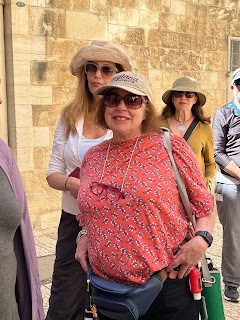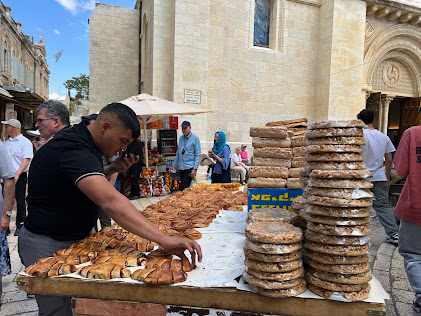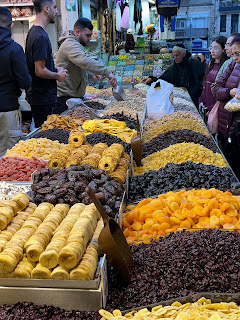Israel Day 6 - May 6, 2023
Jerusalem is a city made up of lots of smaller mini-cities. The more modern part of Jerusalem, where our hotel was located, was built and settled by Jewish immigrants who came to Israel in the years before 1967 when the ancient walled “Old City” was in the hands of the Jordanians. The Old City is familiar to the world as the birthplace of Judaism, Christianity, and Islam. The contrast between these two sides of Jerusalem is amazing: On the one hand, there is a bustling, contemporary, metropolitan area, and just across a beautiful valley it is easy to look right at the walls to the ancient part of Jerusalem known as The Old City. Jerusalem is set apart from the rest of the landscape – and most other ancient cities -- by its large stone walls which when the sun shines on them turn a yellow-gold color. On Shabbat morning, Saturday, we began our tour in the Old City, which is subdivided into four neighborhoods or quarters: the Armenian, the Jewish, the Christian, and the Muslim Quarters. We walked through the narrow and steep alleyways and observed people and customs from throughout the world. We spent time in each of the four quarters – discovering the hidden gems of the people who have lived, worked, and prayed there for centuries. We also got an important glimpse into how ordinary residents of Jerusalem and their many differing languages, customs, and religious traditions live together in such a small and intense area.
We spent a bit of time at the Jaffa gate, the main entrance to the Old City from the western part of Jerusalem. We imagined all the people and cultures and religions that have passed through this gate before us – and enjoyed the sight of a multiplicity of people, nationalities, ages, ethnicities, and religious practices. We spent time in the Church of the Holy Sepulcher in the Christian Quarter, looked up and saw the famous Al-Aqsa Mosque, walked through the fascinating Armenian Quarter, and finally arrived in the beautiful Jewish Quarter, which has been built and re-built over the millennia – most recently between 1967 and today. We enjoyed a short Shabbat service at what is known as Robinson’s Arch, the only egalitarian space along the walls of the Old City where men and women are permitted to pray together and that is welcoming to non-Orthodox Jews and non-Jews alike.
Following our service, we left the Robinson’s Arch area and walked over to the “Kotel” – the Wailing or Western Wall. We looked at its enormous stones and imagined the many centuries in which Jews have yearned to go to the Wall but were unable to because it was controlled by Jews so seldomly in Jewish history. We thought about the hard-won Six-Day War of 1967, when the young State of Israel fought valiantly against the Jordanians to finally overtake the Old City of Jerusalem and connect it with the newer, Western Jerusalem, into a united whole. While Jerusalem is today anything but a united city, the beauty and harmony of co-existence, at least while we were within its walls, belies the political and religious intensity that characterizes Jerusalem. We had lunch together at a fabulous restaurant in a bustling section of the Arab Market and then went back to our hotel for some free time and dinner on our own.
That evening, some just took a walk for dinner, others went to one of the many weekly protests that have been occurring in Israel and in Jerusalem in efforts to pressure the Government on social and civil issues of concern to the Democratic state, and others just relaxed in the area of the hotel.















Comments
Post a Comment